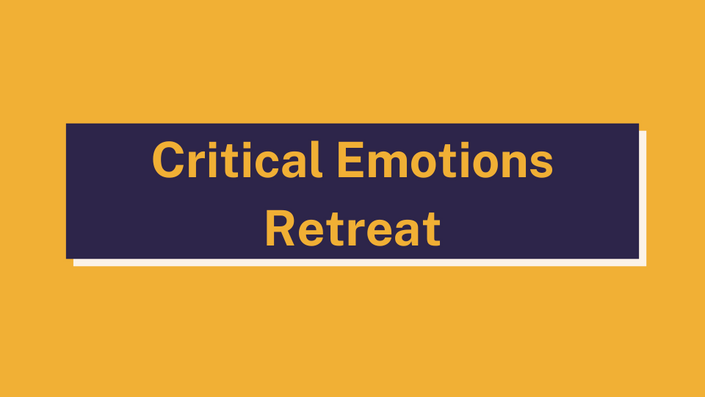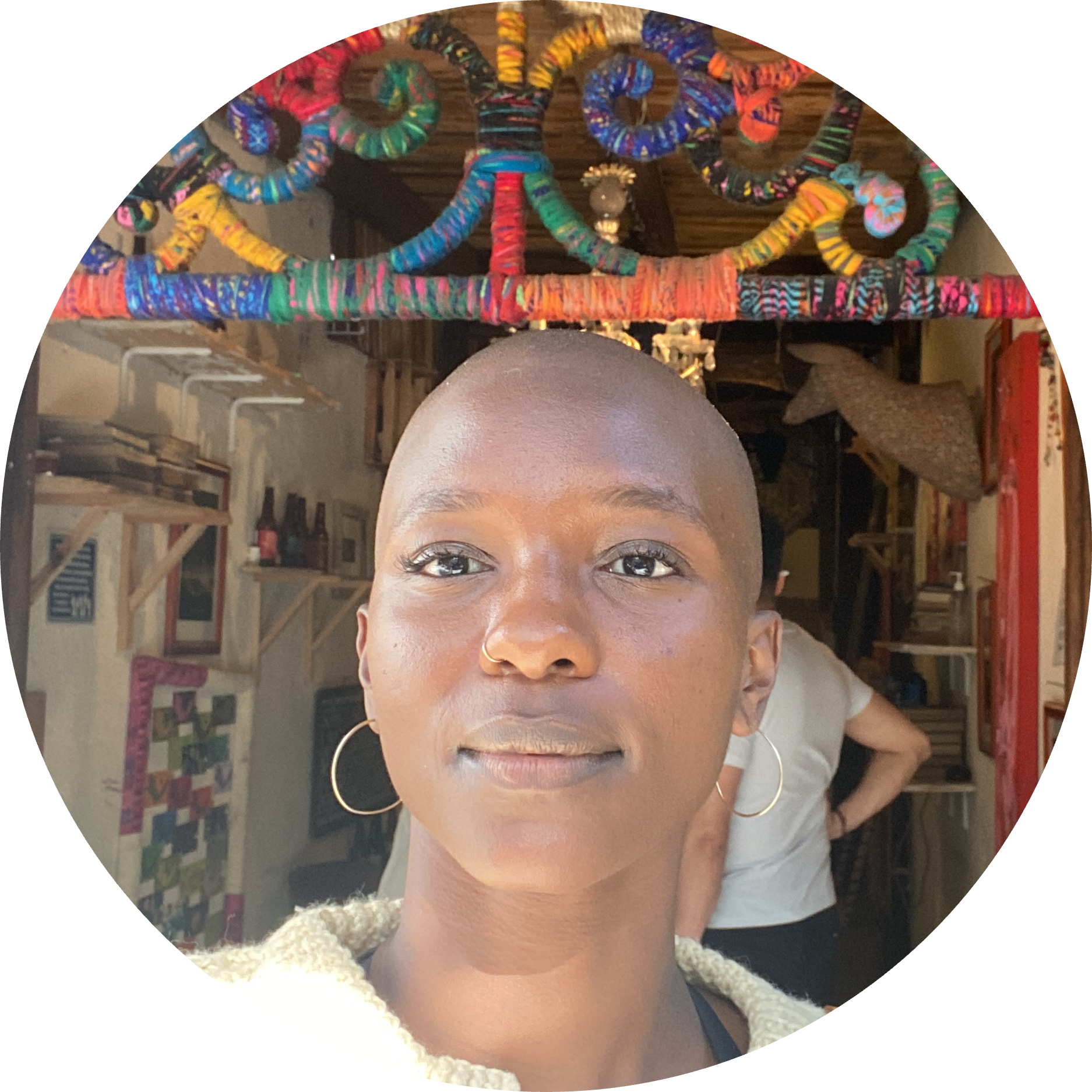
Critical Emotions: Retreat
Note: this is a custom workshop. Read more below to learn about the content, and if/when you're ready to explore what this offering could look like for your team, use
👉🏽this link👈🏽 to schedule a pressure-free discovery call. If you end up wanting to move forward, we'll work together to schedule a day/time that works for both of us!
###
In order to see the systemic problem we’re working to solve more clearly, we must reclaim and productively, intentionally, and collectively process key emotions that we’ve likely spent our lives misunderstanding and avoiding, mistakenly viewing them as distractions in our movement work.
Insecurity, Despair, Confusion and Tension – when processed productively – improve our vision and perspective of the injustice we are trying to see and subvert. By bringing into sharp relief the psychological conditioning we receive around the particular system of oppression that we are trying to transform, critical emotions can help us pinpoint how that system survives and thrives, and therefore, what might start to topple it. On the other hand, unprocessed critical emotions affect our ability to perceive systems of oppression clearly, because they ensure that we will stay constrained by the limitations of the so-called “change-making” paradigms in which we have been indoctrinated by those systems of oppression themselves.
In this way, the four critical emotions aren’t personal, they’re purposeful – when unacknowledged and unprocessed, they have real and severe consequences for our work, adversely impacting our worldview, our assessment of relationships and dynamics, our understanding of what is possible, and our capacity to take risks, just to name a few.
We, however, think that the presence of these emotions is actually a harbinger of hope – a weathervane of sorts that lets us know we’re working on problems consequential enough to warrant our time, heart, and energy. Perhaps that’s why they’re so critical! To get more specific:
- Despair signals that the old ways are no longer tenable and that new ways must be forged.
- Confusion is a right of passage resulting from finally setting down old ways of thinking and being.
- Tension arises when we finally see ourselves as truly inextricable from the problems we’re working to solve and the systems we’re aiming to dismantle – it helps us know that we’re fully engaged in our change-making work and in right relation to our problem, because the system of oppression is not just outside of us…it’s also inside.
- Insecurity signals that the problems we’re working on are big and important and impact many people in ways that are significant and chronic.
In order to create truly transformative change, we must recognize and intentionally address our experience of critical emotions during our redesign efforts. Understanding the impact of critical emotions should never be relegated to the back burner, but rather integrated effectively into the ways our organizations do the work they do. If we do this, we can utilize equitable design not only to process our experience of critical emotions, but also to mine their wisdom for new strategies that will help us tackle these problems and also improve our ways of working together.
To be more specific, we often dissociate from our experience of despair, insecurity, confusion, and/or tension by moving too fast, too quickly, and too soon in various aspects of our work:
- Too fast: In our urgency to address problems and push past our own confusion and experiences of tension, we may overlook the vital step of understanding the problem deeply, which includes patiently interrogating its various levels of causation, contributing factors, and complicit parties (which often includes ourselves in some capacity).
- Too much: Being unable to sit with insecurity and confusion can lead us to taking on an overwhelming number of tests and prototypes or jumping straight to implementing solutions without pacing ourselves, both of which hinder our ability to learn effectively.
. - Too soon: Repressing despair and insecurity can cause us to embrace solutions that might not be exactly what we want to see in the world, but appear achievable enough to feel like we’ve done something, potentially diverting us from the most impactful path.
If it’s challenging to focus on the upsetting aspects of the problem that you’re trying to solve, then you must process and utilize critical emotions in order to see your problem more clearly:
Despair: From giving up to giving up on
We may start off and feel a sense of despair when we identify what it is that we want to shift, and then mistake this despair to be a sign that we ought to give up. In actuality, this critical emotion is calling us to have the courage to give up on a societal strategy that will never benefit us or our community. For instance, prison abolitionists have healthily utilized their despair by becoming entirely hopeless about prisons! This also means that their understanding of the future solution must be devoid of a carceral ethic (punishment, shame, and disposability). We all need to decide what it is that we’re hopeless about, using our despair to hone in on what we are moving against, and increasing our commitment to moving towards new possibilities – knowing that we can’t go back home to our old ways.
Despair allows us to more clearly answer: What is the acute and chronic rupture caused by the problem that you ought to move against? What experience, interaction, behavior related to your problem space would you like to bring out of the shadows so that people understand the true damage of this injustice?
Confusion: From false clarity to purposeful disorientation
We shy away from being confused about the problems that we’re attempting to tackle, misunderstanding confusion to be a sign that we’re out of control or out of our depth. After all, our confusion has so often been used against us or referred to as a character flaw, so instead we posture or act like experts. We may even limit our exploration of the problem at hand to what we currently know, which necessarily limits what we can see and find.
But confusion is not a personal defect. Confusion is a right of passage, a necessary part of moving to new realities. We must build our capacity for getting wondrously lost, or as Bayo Akomolafe calls it, “really working to become a fugitive” – learning to set down old ways of thinking and becoming purposefully disoriented so we can see the problem anew.
Confusion allows us to more clearly answer: How have we been taught to see this moment? How can doubt be used to help us understand what's happening here with more fidelity? How can our disorientation actually serve us?
Tension: From outside to inside
We will feel tension within ourselves and our team as we learn how we all are complicit in this very system that we’re trying to unravel or overturn. We might find that the way we think about the problem, feel about the problem, approach the problem is a manifestation OF the problem itself (as Bayo Akomolafe points out). This can be heavy work when all we want to do is point the finger outside of ourselves! We need to embrace this part of the process that we all go through…and that the system of oppression is not outside, it’s inside all of us to varying degrees and in complicated ways. Unraveling this system requires intentional inner work and purging.
Tension allows us to more clearly answer: Who is a part of the acute and chronic rupture? How might our ideas about and relationship to the problem be inadvertently holding up the problem?
Insecurity: From backing away to moving towards
When you’re close to creating something that the world really needs, you're going to start feeling the fire a bit. You’re going to feel insecure! And you might mistake the temperature turning up or your insecurity as evidence that you should back away from the concepts, approaches, or strategies that you’ve been playing around with, but we say NO – move towards it instead. Your panic is often a false alarm. Your insecurity is actually a good sign.
When you feel this emotion, try to refrain from responding with artificial overconfidence or hiding your feelings/yourself. You are in a society that has created that insecurity for a purpose. It wants you to feel insecure about dreaming big. It wants you to think that transforming things is IMPOSSIBLE or IMPROBABLE. Embrace it. Your insecurity is socially and culturally constructed. No need to posture like you don’t feel it. We should be proud of that insecurity and lean into it collectively. In fact, if we feel insecure or foolish…we might be onto something! Our insecurities may signal us to the eureka moments that are hidden in plain sight, visibly only to those that would be “foolish” enough to grasp them.
Insecurity allows us to more clearly answer: What future feels too scary to allow ourselves to imagine? How can we dream big in our movement toward this reality?
~
Because we’re working on refining this offering this fall during the last semester of Issachar’s Apprenticeship, we’re trying to run as many of these workshops as possible, so we’re offering them at our lowest possible rate: just 5K per day-long session for a team of up to 24 participants.
💃🏽Next steps + How to enroll💃🏽
If you’re interested, the next step is to use 👉🏽this link👈🏽 to schedule a time to chat with us about your team's specific context and needs. If you're ready to move forward after that conversation, we'll give you instructions for how to tender payment. And if you're not ready, there won't be any pressure or obligation -- we approach these discussions as opportunities to understand your challenges and give you all the info you need to make the best decision for your team 💝.
Your Instructor

Issachar Curbeon (she/her) is a curriculum developer, design researcher and coach. For the past two years, she has been the first Equity Meets Design Apprentice, developing a unique approach to design equity which considers the way that distress and emotions can be utilized to create a more productive design cycle.
Before her apprenticeship, she worked In partnership with mission driven organizations, teams and individuals, cultivating conversations, tools and playful experiments that inspired leaders to explore innovative decisions, practices and strategies. Her current experiments include: a) designing curriculum at the intersection of design thinking, nervous system theory and emotions and b) designing “field trips'' for design researchers in Brooklyn to “despairing locations” to better understand the birth justice ecosystem. Her passion for exploring the intersections of race, gender, class, and health was shaped during her undergraduate studies at The New School in New York City.
Since 2014, she has presented at conferences in South Africa, Los Angeles, Atlanta and Washington D.C, advocating for the reproductive health, rights and justice of Black girls. Issachar received the ELLA Fellowship (2014) and the Generative Fellowship (2016), which allowed her to use design justice to create innovative strategies in her approach to fighting against reproductive oppression. She has previously worked with mission driven non-profit organizations such as Black Women for Wellness, the Women’s Leadership Project, Transitions Family Violence Center, the International Rescue Committee, Corealign, America on Tech, Chicago Abortion Fund, Take Action Minnesota, Planned Parenthood Federation of America, Abortion Care Network, and Momsrising.